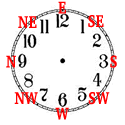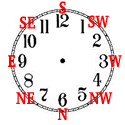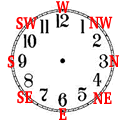
In what direction do you face to begin a particular Taijiquan or Qigong form?
In what direction to you point and aim the arrow in the Eight
Section Brocade Qigong form?
In what direction do you step when moving into a particular posture?
In what direction does your right arm or left arm move in a particular posture?
When doing the Yang 108 Long Form, in what direction
do you face in Single Whip?
When you end the Wild Goose Qigong form, in what
direction are you facing?
These, and other directional questions, are an essential part of learning all
Taijiquan and
Qigong forms.
In the early morning, I now begin facing west so the sun is at my back. When I practiced the Yang long 108/88 form at a local gym with others in 2000, we faced east to take advantage of the longer side of the basketball court. When we practiced Li Ho Ba Fa Taijiquan in 1988, we began the form facing north. In the hot summer afternoon, I now begin facing east when doing Yang forms, so that the hot sun is at my back or my left side. At night, in my backyard, I now usually face south at the start of the form. On my back porch, on rainy days and nights, I begin facing west when doing Taijiquan and Qigong forms.
Some masters recommend that you always try to begin the form facing north. In my opinion, the direction in which you begin facing at the start of a form is rather arbitrary, and based on the shape of the space you will practice in, convenience, custom and circumstance. Nevertheless, after choosing the direction in which to begin facing, all other directions you face in each Taijiquan Form sequence are usually programmed in a established directional sequence. In addition, some adjustments in the directions for facing and moving must, of course, be modified depending upon the space available in your solo practice area and/or the positions of nearby students in a large class.
It is always difficult to come up with understandable written descriptions for
how to position
the parts of the body when developing written instructions for doing a qigong or taijiquan form. To solve this problem, I have adopted a
directional nomenclature
relative to a 12 hour clock.
When the center of your chest and navel face the 12 o'clock position,
your right side faces 3 o'clock,
your back side faces 6
o'clock,
and your left side faces 9 o'clock.
Whatever position you take at the start of the form, whatever direction the center of your chest and navel face, consider that starting position to be facing the 12 o'clock position.
| Key | Clock Hour Direction |
Compass Direction A |
Compass Direction B |
Compass Direction C |
Compass Direction D |
| 12 | 12:00 o'clock | North - Front | East - Front | South - Front | West - Front |
| 1 | 1:30 o'clock | Northeast | Southeast | Southwest | Northwest |
| 3 | 3:00 o'clock | East - Right | South - Right | West - Right | North - Right |
| 4 | 4:30 o'clock | Southeast | Southwest | Northwest | Northeast |
| 6 | 6:00 o'clock | South - Back | West - Back | North - Back | East - Back |
| 7 | 7:30 o'clock | Southwest | Northwest | Northeast | Southeast |
| 9 | 9:00 o'clock | West - Left | North - Left | East - Left | South - Left |
| 10 | 10:30 o'clock | Northwest | Northeast | Southeast | Southwest |
Some might find the following diagrams useful:
| Direction A Face North |
Direction B Face East |
Direction C Face South |
Direction D Face West |
|
|
 |
 |
 |
When I first watch and study a Taijiquan or Qigong form, I adopt Direction A, Facing North, as my standard of interpretation. I take the center of my chest and navel pointing due north as the 12:00 o'clock position. My right side faces due east towards the 3:00 o'clock position. My backside faces due south towards the 6:00 o'clock position. Finally, my left side faces due west towards the 9:00 o'clock position. One can easily convert the my starting interpretation and description into any other cardinal direction using the above charts and diagrams.
Here is a chart for Direction A:
When the center of your chest and navel face the 12 o'clock position,
your right side faces 3 o'clock,
your back side faces 6
o'clock,
and your left side faces 9 o'clock.
| Directional
Instructions Used in describing the Chen Style of Taijiquan, Old Frame, First Form, Laojia Yilu
|
|||
| Key | Clock Hour Direction |
Compass Direction A |
|
| N12 | 12:00 o'clock | North - Front Side of Body | |
| NE1 | 1:30 o'clock | Northeast | |
| E3 | 3:00 o'clock | East - Right Side of Body | |
| SE4 | 4:30 o'clock | Southeast | |
| S6 | 6:00 o'clock | South - Back Side of Body | |
| SW7 | 7:30 o'clock | Southwest | |
| W9 | 9:00 o'clock | West - Left Side of Body | |
| NW10 | 10:30 o'clock | Northwest | |
This method can be used to describe a posture like Yang Single Whip (Chest W 9, R Arm N 12, L Arm and Palm W 9, Face and Eyes W 9). Or, Yang Diagonal Slant Flying (Chest NW 10, Right Arm NE 1, Left Arm SW 7, Face and Eyes NE 1).
Remember that "NE 1" is a
key, or abbreviation for facing true NE to the 1:30 position;
or "SW 7" is the abbreviation or key for facing true SW to the
7:30 position.
Another way to consider this issue of providing directions is to indicate the direction of the opponent you are striking. For example, Diagonal Slat Flying is attacking a opponent who is in the NE 1 position. When I described the Yang Style long and short hand forms, I gave the direction the chest faces at the end of a movment. I welcome your comments and suggestions.
Waving Hands Like Clouds Homepage
© Michael P. Garofalo, May 3, 2005, All Rights Reserved
Cuttings: Haiku and Short Poems